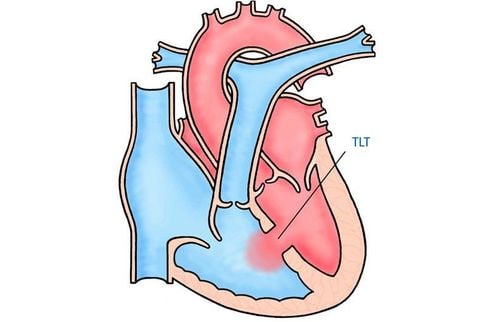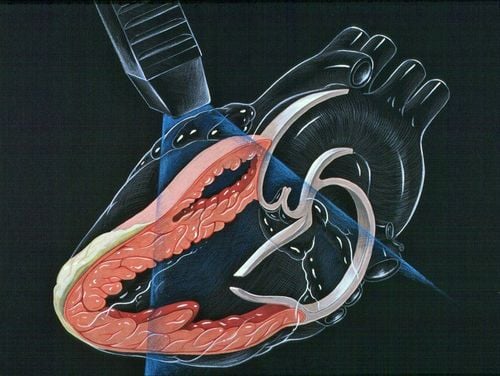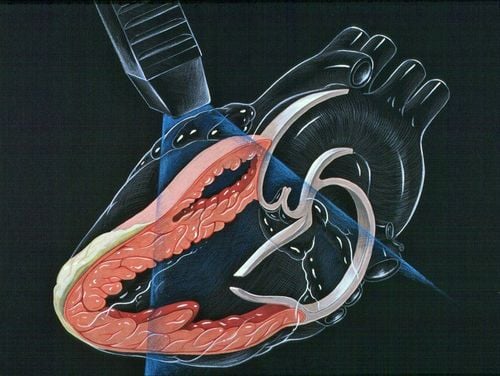This is an automatically translated article.
Color Doppler echocardiography is a non-invasive diagnostic technique for ventricular septal defect, which helps to accurately assess the location and size of the orifice, individual or combined lesions. Ventricular septal echocardiography has many advantages such as fast execution time, high flexibility, and can be combined with stress tests.
1.Overview of ventricular septal defect
Ventricular septal defect (VSD) is a congenital anomaly in which a defect in the septum occurs, leading to hemodynamic communication between the right and left ventricles. Ventricular septal defect is a common cardiac anomaly, second only to aortic regurgitation, accounting for approximately 25% of congenital heart diseases. Children with ventricular septal defect are often slow to grow and are at risk of dangerous complications if not detected early and treated promptly.
During fetal development, the cardiovascular system begins to form at the beginning of the 3rd week and begins to function on the 21st day. Ventricular septal defect occurs due to a disorder in the formation of the ventricular septum. Based on pathology, it can be divided into 4 main types of ventricular septal defect:

Thông liên thất
Pericardial septal septal defect: the hole is located high, in the membranous part of the interventricular septum, at the junction of the tricuspid valve and aortic valve. Ventricular septal defect: also known as ventricular septal defect near the apex of the heart. The septal defect can be anywhere from the lower part of the septum to the apex of the heart. ventricular septal defect or common ventricular septal defect: this type of ventricular septal defect is usually located high in the septum, is wide, has little ability to close on its own, and is often associated with damage to the atrioventricular valves. Ventricular septal defect: the opening is located in the very high part of the interventricular septum where it meets the aortic valve and the pulmonary valve. For newborns, ventricular septal defect is the most common form (accounting for 80%), ventricular septal defect is second (accounting for 5-10%).
If ventricular septal defect is severe, symptoms may appear in the first months, even in the first days after birth. The child has difficulty breathing, rapid breathing, blue skin (especially on the lips and fingernails), poor feeding, rapid fatigue. In addition, children often have pneumonia and repeat it many times. Signs and symptoms vary depending on the size of the ventricular septal defect.
2.Diagnosis of ventricular septal defect by color Doppler echocardiography

Siêu âm tim Doppler màu có thể đo áp lực động mạch phổi
Echocardiography of ventricular septal defect is a mandatory investigation to confirm the diagnosis and make treatment decisions. There are many methods of echocardiography that can be used such as black and white ultrasound, color doppler ultrasound, 3D ultrasound,... In which, color Doppler echocardiography is a diagnostic technique for septal defect. Ventilation is commonly used with many advantages such as quick implementation, can be done in the ultrasound room or done right at the bed in case of emergency. May be combined with stress tests to evaluate the heart during exercise. On color Doppler echocardiography, it is possible to identify:
Location of ventricular septal defect, size of the septal defect Investigate the size of the heart chambers, wall thickness, measure the pulmonary artery pressure, determine whether the shunt is left or right or reversed. Identification of associated lesions To perform ventricular septal defect echocardiography by color Doppler method, the patient is instructed to lie supine, leaning to the left side and lying in a resting state. The patient will have an electrocardiogram at the same time during the ultrasound. The sonographer will sit on the right side of the patient, with the right hand holding the transducer, the left hand adjusting the buttons of the machine. The transducer is placed at the left sternal border, in the third or fourth intercostal space. The transducer makes an angle of 80-90 degrees with the patient's thoracic plane. Ultrasound waves are projected directly to the heart structures to help measure the thickness and width of these structures. The doctor can adjust the transducer to have different viewing angles and assess the patient's condition through the parameters on the ultrasound.
3. ventricular septal defect on color Doppler ultrasound

Hình ảnh thông liên thất trên siêu âm Doppler màu
The ventricular septal defect on color Doppler is an echogenic area where the foramen rim is normally enhanced. Large ventricular septal defects are usually easily recognized and visible in all views. Small ventricular septal defects are often difficult to isolate and need to be identified on multiple sonographic profiles.
3.1. Parasternal ultrasound view Echocardiographic image of ventricular septal defect in major axis view:
Pericardial septal defect can be seen if the septal defect is large, located below the anterior wall of the aorta. A funnel-shaped ventricular septal defect is seen below the foramen of the aorta and the pulmonary artery. Myoventricular septal defect: seen in the muscular septum, near the apex of the heart. While the ventricular septal defect is not visible in this view. Echocardiographic image of ventricular septal defect in short axial view:
Pericardial septal defect is seen at 11 o'clock above the interventricular septum ring, below the aortic valve, in front of the tricuspid septal leaflet. The ventricular septal defect was observed at 13 o'clock, below the pulmonary valve. Ventricular septal defect below the two large aortic valves at the 14 o'clock position, just below the pulmonary valve. Ventricular septal defect observed in biventricular design, near papillary muscle. The ventricular septal defect is not evident in this view. 3.2. Image of ventricular septal defect on apical Doppler echocardiography

Hình ảnh siêu âm Doppler màu tim thai thông liên thất
Pericardial septal septal defect can be visualized below the tricuspid septal ventricle but may be false. Receiver ventricular septal defect, mitral septal septal septal defect, and tricuspid valve. Ventricular septal defect: not observed in this view. 3.3. Image of ventricular septal defect on Doppler ultrasound of substernal ultrasound section The periventricular septal defect is clearly visible. A funnel-shaped ventricular septal defect is seen in the minor axis below the pulmonary valve. The ventricular septal defect can be seen in a four-chamber view. The trabecular ventricular septal defect is seen in the short axial view and often has many holes. 3.4. The ultrasound results depend on the location of the ventricular septal defect. The periventricular septal defect is observed in the major parasternal axis, most clearly in the substernal and short parasternal views.
When the foramen extends into the trabecular muscle: can be seen in the great axial view of the sternal side. When the foramen extends toward the interventricular septum of the receiving chamber: visible in the apical 4-chamber view.

Thông liên thất được phát hiện bằng Doppler mầu (VSD jet): dòng chảy từ thất trái (LV) qua vách liên thất sang thất phải (RV), đi về phía đầu dò được để ở phía thất phải nên có mầu khảm đỏ
May extend toward the interventricular septum of the funnel: observed in the parasternal view of the short axis across the two large aortic valves. Color Doppler ultrasonography shows colored mosaic flow in the right ventricle. As the foramen widen toward the muscular interventricular septum, the wide colored stream extends toward the apex of the heart. If the stoma is toward the ventricular septum of the funnel, the mosaic flow is directed toward the pulmonary valve. Receiver ventricular septal defect: observed in the apical 4-chamber view and in the substernal 4-chamber view, abnormalities can be seen in the attachment position of the tricuspid valve.
ventricular septal defect:
sternal view of the great axis of the lower part of the interventricular septum; Short axial parasternal view, ultrasound beam through mitral valve toward papillary muscle; View of the four chambers of the heart at the apex and below the sternum, toward the apex. When performing color Doppler, the color flow through the interventricular septum is at a relatively high position, and many holes can be seen. Ventricular septal defect:
Observe in short axial parasternal view and substernal view. When color Doppler is performed, the color flow across the interventricular septum is directed toward the aortic valve. Color Doppler ultrasound is a modern imaging technique, capable of helping doctors observe and properly diagnose ventricular septal defects for timely treatment.
Although it is a dangerous disease and can leave many complications, if the ventricular septal defect is detected early at reputable specialized facilities and has an early treatment plan, it will help the patient recover completely.
Currently, Vinmec International General Hospital is not only well-regarded for its modern facilities, experienced medical team, but also as an address for early examination and diagnosis. and successfully treated many cardiovascular diseases, including ventricular septal disease. In addition, Vinmec is also equipped with a modern color Doppler ultrasound machine, giving clear image results for examination and diagnosis. After the results are available, the Department of Diagnostic Imaging also cooperates with many other specialties to determine the stage of the disease to have an effective ventricular septal defect treatment regimen, which will soon bring good health to the patient.
Please dial HOTLINE for more information or register for an appointment HERE. Download MyVinmec app to make appointments faster and to manage your bookings easily.













